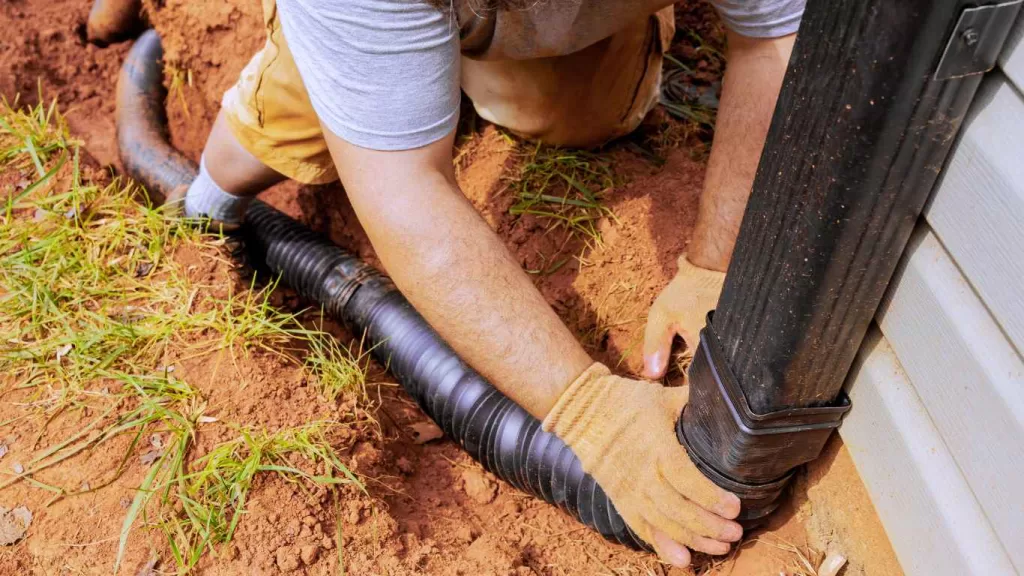
Solving Exterior Drainage With Effective Drainage Solutions
From heavy rains to melting snow, the seasonal fluctuations in weather can pose significant challenges to the integrity of your property. Proper exterior drainage isn’t just a matter of convenience; it’s a critical aspect of maintaining the structural integrity and aesthetics of your outdoor spaces. Without effective drainage solutions in place, water can wreak havoc, causing erosion, flooding, foundation damage, and even compromising the safety of your property.
Keep reading as we shine a spotlight on the common exterior drainage issues that homeowners encounter. Additionally, we guide you through potential pitfalls and offer practical drainage solutions to protect your property against water-related woes. Whether you’re dealing with puddles forming around your foundation after a heavy rainstorm or struggling to navigate through waterlogged areas in your yard, understanding the root causes of these issues and implementing targeted drainage solutions is paramount to safeguarding your investment and ensuring the longevity of your outdoor spaces. Prefer to leave it to the experts? Contact Venyscapes today for a free consultation and estimate.
Understanding Exterior Drainage Issues
Understanding the challenges posed by exterior drainage issues is the first step towards implementing effective yard drainage solutions. Let’s look deeper into these common drainage problems. Keep reading as we explore why addressing drainage is crucial for maintaining the integrity of your outdoor spaces.
Standing Water:
Standing water is one of the most visible and immediate signs of poor drainage. Whether it accumulates in low-lying areas of your yard or forms puddles around your home’s foundation, standing water not only detracts from the aesthetic appeal of your property but also poses serious risks. It creates breeding grounds for mosquitoes and other pests, increases the risk of slip and fall accidents, and can lead to water infiltration into basements and crawl spaces.
Soil Erosion
Soil erosion occurs when water runoff carries away topsoil, leaving behind barren patches of land and exposing the roots of plants and trees. Beyond the loss of fertile soil, erosion compromises the stability of slopes and embankments, leading to landslides and sinkholes. Additionally, sediment runoff from erosion can contaminate water bodies, harming aquatic ecosystems and compromising water quality.
Basement Flooding
Basement flooding is a nightmare scenario for homeowners, often resulting from poor exterior drainage around the foundation. Water seepage through cracks in the foundation walls or gaps around basement windows can lead to costly water damage, mold growth, and structural instability. Addressing exterior drainage issues is essential for preventing water from infiltrating below-grade spaces and wreaking havoc on your home’s foundation.
Foundation Damage
Excess moisture around the foundation can cause the soil to expand and contract, exerting pressure on the foundation walls and leading to cracks, shifting, and settling. Over time, these structural issues can compromise the stability of your home, jeopardizing its safety and resale value. Proper exterior drainage is essential for directing water away from the foundation and maintaining a stable moisture balance in the surrounding soil.
The Importance of Proper Grading, Soil Composition, and Landscape Design
Proper grading, soil composition, and landscape design are fundamental elements of effective exterior drainage solutions. Grading refers to the slope or incline of the land. The slope should be directed away from buildings and towards drainage outlets to facilitate water runoff. A well-graded landscape prevents water from pooling around structures and encourages proper drainage away from vulnerable areas.
Equally important is the composition of the soil, which plays a significant role in water absorption and drainage. Soil that is compacted or composed of heavy clay tends to retain water, exacerbating drainage problems. Amending the soil with organic matter can improve its drainage capacity and promote healthy root growth for plants.
Furthermore, thoughtful landscape design can help mitigate drainage issues by incorporating features such as swales, berms, and retention ponds to channel and manage water flow. Strategic placement of vegetation, such as deep-rooted plants and trees, can also help stabilize soil, reduce erosion, and enhance water absorption.
By prioritizing proper grading, soil composition, and landscape design, homeowners can proactively address exterior drainage challenges and create resilient outdoor environments that are both functional and visually appealing.
Assess Drainage Needs During Rain Storms
Assessing your property’s drainage needs is a crucial step in developing effective solutions to mitigate water-related issues. By understanding the drainage patterns and factors influencing water flow on your property, you can identify problem areas and implement targeted interventions. Here are some tips for assessing your property’s drainage needs:
Observe Water Flow During Rainfall:
- During periods of rainfall, take note of how water moves across your property. Pay attention to areas where water accumulates or flows towards structures, pathways, or low-lying regions.
- Look for signs of erosion, such as exposed roots, sediment deposits, or gullies, which indicate areas of concentrated water runoff.
Check for Pooling Water:
- Inspect your yard for areas where water tends to pool or collect, especially after heavy rainstorms. Common trouble spots include depressions in the lawn, sunken areas near downspouts, and poorly graded sections of the landscape.
- Use a level or ruler to assess the depth of standing water and determine the extent of drainage problems.
Inspect Gutters and Downspouts:
- Examine the condition of your gutters and downspouts to ensure they are free of debris, clogs, and damage. Blocked gutters can cause water to overflow and cascade down exterior walls, leading to water infiltration and foundation damage.
- Check that downspouts extend at least 3-4 feet away from the foundation to direct water away from the structure and prevent pooling near the base.
Evaluate Topography and Soil Type:
- Take note of the natural contours and slopes of your property, as these influence water drainage patterns. Areas with steep slopes or uneven terrain may require special attention to prevent erosion and runoff.
- Consider the soil type prevalent on your property, as different soil compositions have varying drainage characteristics. Sandy soils drain quickly but may struggle to retain moisture, while clay soils hold water but can become waterlogged and compacted.
Consider Existing Landscaping Features:
- Assess the impact of existing landscaping features, such as paved surfaces, retaining walls, and vegetation, on water flow and drainage. Paved areas can create impervious surfaces that contribute to surface runoff, while retaining walls may alter natural drainage pathways.
- Evaluate the placement and density of vegetation, as dense foliage can intercept rainfall and reduce soil erosion, but overgrown vegetation may obstruct water flow and exacerbate drainage issues.
Effective Exterior Drainage Solutions
Effective drainage solutions are essential for managing water runoff and protecting your property from damage. Let’s delve into various drainage techniques and solutions to address common drainage issues:
Grading and Sloping for Exterior Drainage:
- Proper grading ensures that the land slopes away from buildings and towards drainage outlets, preventing water from pooling near structures.
- To adjust soil slopes, use a transit level or laser level to identify high and low points, then redistribute soil to create a gentle slope away from buildings.
- Swales and berms can be incorporated into the landscape to redirect water flow and prevent erosion. Swales are shallow, vegetated channels that collect and convey water, while berms are raised mounds of soil that divert water away from sensitive areas.
French Drains for Exterior Drainage:
- French drains are underground drainage systems designed to channel water away from problem areas.
- To install a French drain, dig a trench along the desired drainage path, line it with landscape fabric, place PVC drainage pipe in the trench, cover the pipe with gravel, and backfill with soil.
- The PVC pipe allows water to enter and be carried away from the site, while the gravel provides filtration and prevents clogging.
Downspout Extensions For Exterior Drainage:
- Downspout extensions are essential for directing downspout runoff away from foundations and walkways.
- Install downspout extensions that discharge water at least 3-4 feet away from the foundation to prevent water infiltration.
- Splash blocks placed at the base of downspouts can help disperse water and prevent soil erosion. Alternatively, consider underground drainage systems that route water away from the property.
Dry Wells and Rain Gardens:
- Dry wells and rain gardens are eco-friendly solutions for managing stormwater runoff and promoting groundwater recharge.
- A dry well is a buried chamber filled with gravel or rock that collects and slowly infiltrates stormwater runoff into the soil.
- Rain gardens are planted depressions designed to capture and absorb rainwater, featuring a variety of native plants that thrive in moist conditions.
- When designing dry wells and rain gardens, consider factors such as soil type, drainage area, and plant selection to ensure effective water management and aesthetics.
Permeable Pavement for Exterior Drainage:
- Permeable pavement allows water to infiltrate through the surface, reducing surface runoff and replenishing groundwater.
- Common types of permeable pavement include porous asphalt, pervious concrete, and permeable pavers.
- Installation methods vary depending on the type of permeable pavement, but typically involve preparing a subbase of aggregate, installing the permeable surface, and ensuring proper drainage through underlying layers.
Retaining Walls For Exterior Drainage:
- Retaining walls help control erosion and manage water flow on sloped landscapes by stabilizing soil and preventing runoff.
- Design retaining walls with proper drainage features, such as weep holes or gravel backfill, to prevent water buildup behind the wall.
- Select materials that are suitable for the site conditions and consider incorporating vegetation or landscaping to enhance aesthetic appeal and ecological benefits.
By implementing these effective drainage solutions, you can mitigate water-related issues in your yard. Additionally, it creates a resilient outdoor environment that withstands the challenges of fluctuating weather patterns.
The Importance of Hiring a Professional Drainage Solutions Company
Hiring a professional drainage solutions company is paramount to ensuring the effectiveness and longevity of your drainage systems. Venyscapes has the knowledge, experience, and specialized equipment necessary to accurately assess your property’s drainage needs. From grading and slope adjustments to the installation of French drains and permeable pavement, we understand the intricacies of drainage design and implementation. Thus, minimizing the risk of costly mistakes and ensuring optimal performance. Moreover, professional drainage solutions companies, like Venyscapes, adhere to industry best practices and local regulations, ensuring compliance with relevant codes and standards. By trusting your drainage and landscaping needs to Venyscapes, you can have peace of mind knowing that your property is in capable hands. Not to mention that you are investing in solutions that will protect your home, enhance its value, and provide long-term benefits for years to come. Contact Venyscapes today to set up your free consultation.
